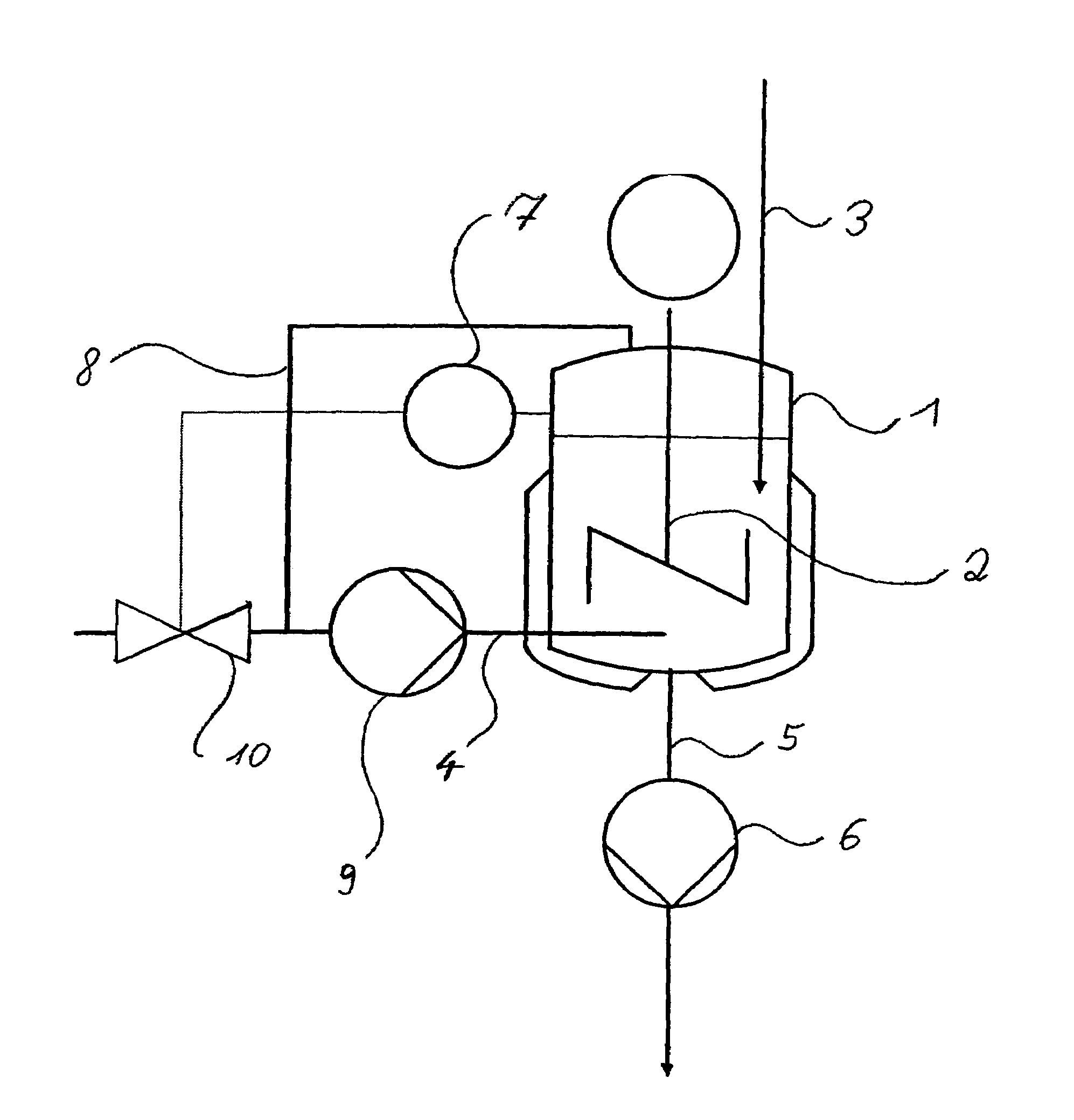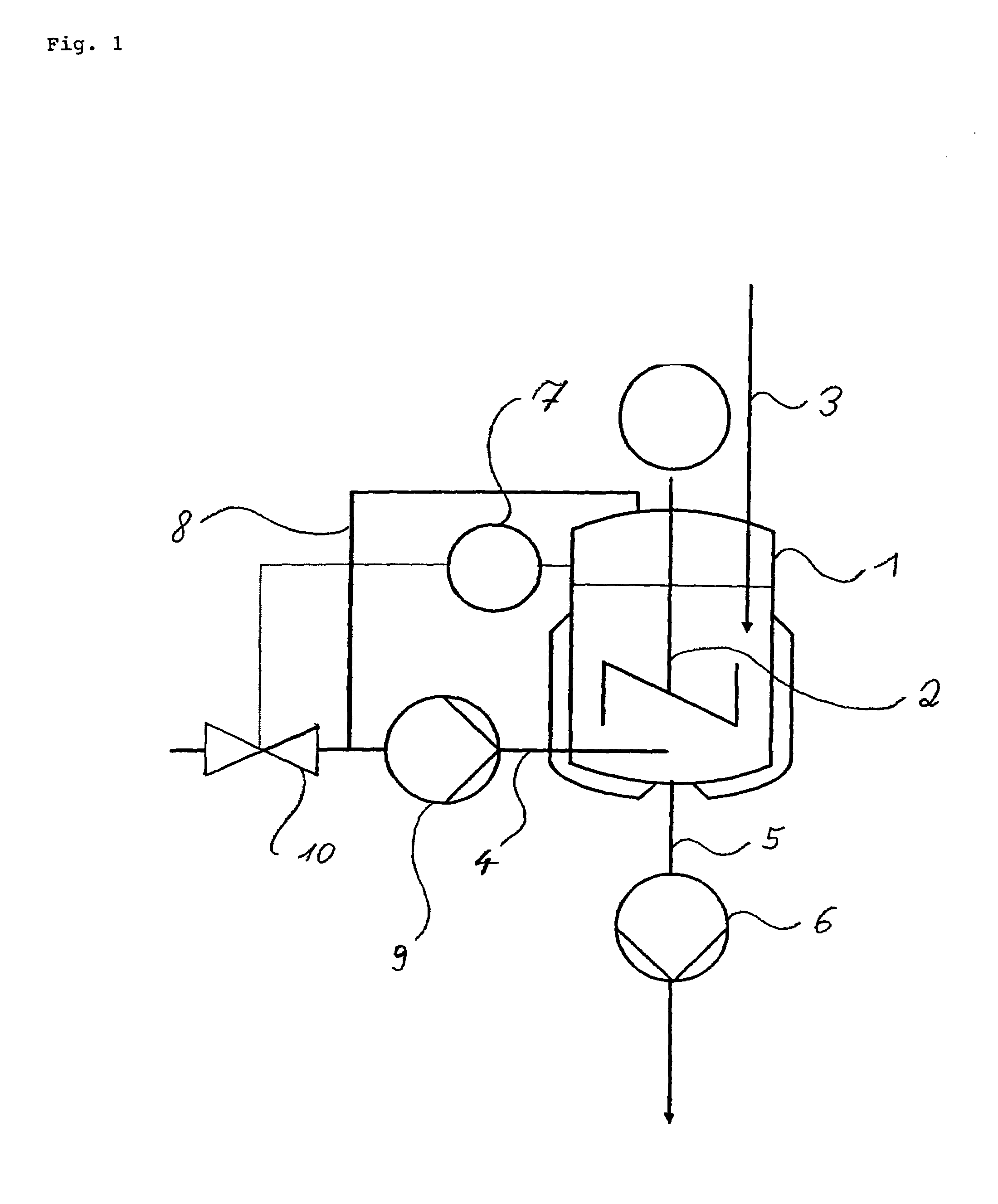Production of ammonium salts of aromatic carboxylic acids
a technology of aromatic carboxylic acid and ammonium salt, which is applied in the preparation of carboxylic compounds, organic chemistry, chemistry apparatus and processes, etc., can solve the problems of wide crystal size distribution, uncontrollable crystal size, and unsatisfactory yields
- Summary
- Abstract
- Description
- Claims
- Application Information
AI Technical Summary
Benefits of technology
Problems solved by technology
Method used
Image
Examples
##ventive example 1
INVENTIVE EXAMPLE 1
[0019]A 2 L double-jacketed reactor equipped with a disk stirrer and baffles was simultaneously charged below the liquid surface with 53.3 g min−1 of a solution of 720 g of benzoic acid in 3280 g of 1,2-dichloroethane (DCE) and gaseous ammonia. The reaction temperature was 90° C., the overall pressure 1.6 bar and the ammonia partial pressure 0.38 bar. From the gas space, 50 l h−1 of gas were circulated by pumping and introduced below the liquid surface. The residence time in the reactor was set to 45 minutes. The resulting ammonium benzoate suspension was continuously passed out through a bottom valve. After 8 residence times, a sample was analyzed: coarsely crystalline, non-agglomerated ammonium benzoate of an average particle size of about 300 μm (the particle size distribution could not be determined, since the particles clogged the sensor of the particle counter); dissolved benzoic acid: <10 ppm.
##ventive example 2
INVENTIVE EXAMPLE 2
[0020]The reactor described in example 1 was simultaneously charged below the liquid surface with 53.3 g min−1 of a solution of 720 g of benzoic acid in 3280 g of DCE and gaseous ammonia. The reaction temperature was kept at 80 to 81° C., the overall pressure at 1.3 bar and the ammonia partial pressure at 0.37 bar. Unconverted ammonia was circulated as cycle gas via a pump at 60 l h−1. The residence time in the reactor was set to 45 minutes. The resulting ammonium benzoate suspension was continuously passed out through the bottom valve. After 8 residence times, a sample was analyzed: coarsely crystalline, non-agglomerated ammonium benzoate; dissolved benzoic acid: <5 ppm; particle size distribution: maximum 90 μm, range 0.93.
##ventive example 3
INVENTIVE EXAMPLE 3
[0021]The reactor described in example 1 was simultaneously charged below the liquid surface with 53.3 g min−1 of a solution of 720 g of benzoic acid in 3280 g of DCE and gaseous ammonia. The reaction temperature was set to 81° C., the overall pressure to 2.1 bar and the ammonia partial pressure to 1.19 bar. Unconverted ammonia was circulated as cycle gas via a pump at 60 l h−1. The residence time in the reactor was set to 45 minutes. The resulting ammonium benzoate suspension was continuously passed out through the bottom valve. After 8 residence times, a sample was analyzed: finely crystalline, agglomerated ammonium benzoate; dissolved benzoic acid: 5 ppm; particle size distribution: maximum 60 μm, range 0.92.
PUM
| Property | Measurement | Unit |
|---|---|---|
| partial pressure | aaaaa | aaaaa |
| temperature | aaaaa | aaaaa |
| pressure | aaaaa | aaaaa |
Abstract
Description
Claims
Application Information
 Login to View More
Login to View More - R&D
- Intellectual Property
- Life Sciences
- Materials
- Tech Scout
- Unparalleled Data Quality
- Higher Quality Content
- 60% Fewer Hallucinations
Browse by: Latest US Patents, China's latest patents, Technical Efficacy Thesaurus, Application Domain, Technology Topic, Popular Technical Reports.
© 2025 PatSnap. All rights reserved.Legal|Privacy policy|Modern Slavery Act Transparency Statement|Sitemap|About US| Contact US: help@patsnap.com


